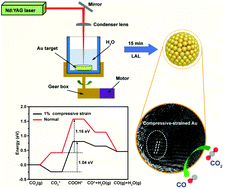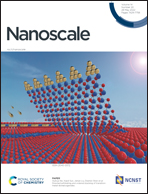Laser-ablation assisted strain engineering of gold nanoparticles for selective electrochemical CO2 reduction†
Abstract
Strain engineering can endow versatile functions, such as refining d-band center and inducing lattice mismatch, on catalysts for a specific reaction. To this end, effective strain engineering for introducing strain on the catalyst is highly sought in various catalytic applications. Herein, a facile laser ablation in liquid (LAL) strategy is adopted to synthesize gold nanoparticles (Au NPs) with rich compressive strain (Au-LAL) for electrochemical CO2 reduction. It is demonstrated that the rich compressive strain can greatly promote the electrochemical CO2 reduction performance of Au, achieving a CO partial current density of 24.9 mA cm−2 and a maximum CO faradaic efficiency of 97% at −0.9 V for Au-LAL, while it is only 2.77 mA cm−2 and 16.2% for regular Au nanoparticles (Au-A). As revealed by the in situ Raman characterization and density functional theory calculations, the presence of compressive strain can induce a unique electronic structure change in Au NPs, significantly up-shifting the d-band center of Au. Such a phenomenon can greatly enhance the adsorption strength of Au NPs toward the key intermediate of CO2 reduction (i.e., *COOH). More interestingly, we demonstrate that, an important industrial chemical feedstock, syngas, can be obtained by simply mixing Au-LAL with Au-A in a suitable ratio. This work provides a promising method for introducing strain in metal NPs and demonstrates the important role of strain in tuning the performance and selectivity of catalysts.

- This article is part of the themed collections: Nanoscale and Nanoscale Horizons: Nanoparticle Synthesis and CO2 capture and conversion


 Please wait while we load your content...
Please wait while we load your content...